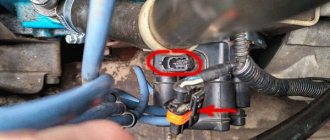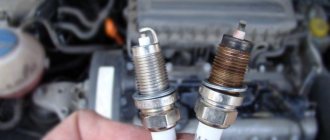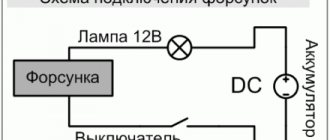January 15, 2015 Lada.Online 308 899 380
To start the engine, you need to ensure that a spark appears at a certain moment to ignite the air-fuel mixture in the cylinders. Problems with starting the engine occur if one or more elements of the system malfunction. The table lists possible reasons why the Priora does not start.
How to check the spark of a Priora
Good evening everyone, dear friends, today I decided to touch on a sore subject on Priora and not only, namely the failure of spark plug coils
. The Prioro engine uses individual Bosch coils, the price today is 450 g
Therefore, I suggest several ways to recognize a non-working coil (by the way, even diagnosticians at stations can’t always tell which coil is faulty and suggest the poke method)) of course, there is a device that checks the performance of the coil, but its price is about 300 USD
and not every diagnostician buys such a thing, thinking that when it will work out)
Let's start self-diagnosis, firstly, inspect the removed coil, the rubber part should be without cracks or tears (this is already a defect)
Also, the spring located inside the coil must be in the correct position
The easiest method is to wrap the coils with thermal tape.
but if this did not help, it means that some of them are definitely dead, after visually inspecting the coils with their full visual performance, we move on to auxiliary methods, namely a banal tester. Many people say that you can’t check the coil with a tester, but you can check it knowing only the initial readings) First, we check the internal resistance of the multimeter and its wires, so as not to make false measurements. To do this, set the switch to the 200 Ohm position and close the probes, mine is 0.3 Ohm
We call the primary winding of the coil; this winding is connected to pins 1 and 3 of the connector. The polarity of the connection does not affect this. The multimeter should show about 0.8 ohms
subtract its own error 0.8 - 0.3 = 0.5 Ohm - the norm. If there are no indications, then we check the quality of the connection of the probes to the coil contacts and the correctness of the connections (we need the outer terminals of the coil connector) and try to ensure better contact; if there are still no indications, then the primary winding is broken and the ICZ is faulty.
If everything is normal with the primary, check the secondary winding of the coil. To do this, move the multimeter switch to the 2000 kOhm position (or 2 MOhm), here the multimeter probes must be connected observing the polarity - red to the spring inside the rubber cap, black to the middle (2) pin of the connector. My working coil has a secondary winding resistance of 342 kOhm.
As for the 2nd coil, it is broken, to be completely sure, I removed the rubber cap, wiped it, knocked, but nothing helped - this coil is faulty and the cartoon shows infinity.
So we are not in a hurry to go to diagnosticians and give money for advice to check by replacing a new one)) first you can try your strength and intelligence)
Thank you all for your attention, good luck in life and on the drive))
The check light came on, the car started running, and after 3 km it stalled. Having opened the hood, I realized that the seal of the third cylinder had melted and leaked. I installed a new one. There is no spark in all cylinders.
- Why does the engine fault light come on and the Priora jerks? – 3 answers
- VAZ Priora ignition coil does not ring - 3 answers
- The car suffocates in the rain, VAZ 2170 – 2 answers
- Troit Priora when cold – 2 answers
- I turn on the ignition, but no current goes to the starter - 1 answer
It is worth checking the fuses and ignition relays and the ECU. Is there an impulse to the injectors? If not, then the problem is with the crankshaft sensor or immobilizer. If so, then you need to check the connector and wires of the ignition coils, the ECU connector, and the problem may also be in the ECU itself.
Subscribe
to our channel in
Index.Zen
Even more useful tips in a convenient format
Many car enthusiasts have encountered the loss of spark on the 16-valve VAZ-2112 engine. What is this defect associated with? The first thing that suggests itself is the ignition. But, in this case, not everything is so simple, since the problem may lie deeper than it seems at first glance.
The video describes a situation when you lose a spark on the road and the car does not start:
No spark prior 16 valves reasons
Welcome to ChipTuner Forum.
Theme Options
The 2nd cylinder on the Priora does not work. Prehistory. Recently I became the owner of a VAZ 2170 16v with a mileage of 90t.km. I began to notice that in the mornings the car did not start the first time, it was idling, then warmed up and after 30-50 seconds, everything was normal, it also squeezed out oil due to crankcase gases. I have made a trail. work: 1. Cleaned the ventilation system. crankcase 2. changed the O-rings on the intake receiver 3. cleaned the throttle valve (along the way for the sake of prevention) 4. changed the NGK spark plugs 5. cleaned all the injectors, measured the resistance - 12.5 ohms on each 6. voltage to the injectors - 8 V, 7 .voltage on the coils is normal 12V. 8. I pulled out the coil from the spark plugs, turned it with the starter - there was a spark. After that the car did not start, I left it overnight, it sat and started, but the problems did not go away. In the cold, the same thing happened. According to diagnostics - misfire in the 2nd cylinder.
Next I decided to flash the ECU 7.9.7. I resoldered the 6.8k Ohm resistor - it didn’t connect, soldered the eprom and 81 contacts on the computer, closed the box and calmed down - I couldn’t fix it, put it in the car, started it - now it’s constantly running both cold and hot. ((.
Maybe because of the ecu. I heard that if the key is broken, one of the cylinders may fail. but there is a spark, there is voltage on the coil and injector. It will not be possible to install a block from another car, because... My unit is somehow connected to the system via an immobilizer. At least I tried to install January 7.2 - it is not diagnosed.
There are still a couple of ideas left in my head, I need to finish them off: 1. Check the timing marks 2. Hydraulic compressors
HELP ME PLEASE! Perhaps it’s my own fault, I need to climb into the car less, I’ll drive more, I’ve learned it, but I need to finish the job. If it doesn't work, I'll go for diagnostics.
Help, I’ve broken my head, the spark has disappeared on my 16-valve Priora, and the car won’t start, fuel is flowing, the computer has been checked - everything is fine, the crankshaft sensor is also intact, but still there is no spark. I have already changed the modules and spark plugs, it started for me once, but the revs did not rise. Now it won’t start at all. There is no spark on the 16 valve Priora.
IKZ device
The Priora coil consists of a primary and secondary winding, between which a core is placed. To contact the spark plug, a spring is used, which is placed in a rubber tip. The IKZ also has a metal screen that protects the coil from high temperatures, because IKZ is installed in the well of the cylinder head, then the temperature conditions there are simply enormous.
The primary winding is wound from thin copper wire with a number of turns of 10,000-15,000.
The secondary winding of the coil consists of 100-150 turns of thick copper wire.
The connection between the coils is electromagnetic.
conclusions
Loss of spark on a 16-valve VAZ-2112 may be a consequence of the failure of several vehicle components at once or each individually. But, if the operations indicated in the article did not help, then you should contact specialists at a car service center who will accurately identify the cause and eliminate it.
It is unlikely that several nodes will fail at once. This has not happened in my practice. Unless, of course, you hit the car properly.
The ignition coil rarely fails because it is initially reliable. But the spark plugs and fuel pump often fail.
Even if the timing phase is off, there should be a spark!
There will be a spark, but not at the right time when the air-fuel mixture arrives.
the article sucks. wrote the teapot. Moreover, the pump and the spark, and the timing belt. even with a broken timing belt there will be a spark. Kettle...boil somewhere else
What does the fuel pump and broken phases have to do with it? The author is in the furnace.
Wrote 100% who themselves have no idea what they are writing, if on the 12th engine if the spark disappears completely, then 80% is the module, and then 5% each of the crankshaft sensor, ignition switch, ECU and a break in the bus from the brain to the module or crankshaft all
Oh yes, I almost forgot the immobilizer and the signaling may be glitchy
Main causes of misfire
There can be many reasons for the problem; even professional mechanics spend more than one hour to identify its source.
The main reasons for misfire in cylinders 1, 2, 3, 4 can be:
- The ignition coil or module has failed.
- Inoperative fuel injector, clogged due to low-quality gasoline.
- Incorrect spark plug gap, which can lead to poor sparking.
- Spark plugs are flooded.
- Breakage of high-voltage wires, increased resistance (non-standard ones are installed), oiliness of contact points.
- A high-voltage wire has fallen off (often happens on Lada Kalina and Granta).
- On an 8-valve engine, the timing belt may jump (during replacement, an error was made due to marks or as a result of excessive wear);
- On a 16-valve engine, the hydraulic compensators are not working correctly.
- Air leak (can be anywhere);
- The compression in the engine cylinders has dropped or is different (applies to cars with high mileage);
- Low pressure in the fuel rail as a result of reduced fuel pump performance.
- Black spark plugs due to carbon deposits on them.
The main reasons for the lack of spark
General view of the engine 10-12 series 16 valves
Not all motorists know the reasons for the loss of spark, much less methods for diagnosing and troubleshooting problems. So, it is worth identifying the main reasons, and then deciphering why exactly they become the cause. Finally, you need to consider ways to eliminate the defect. So, what reasons could cause the spark to disappear:
- Failure of the fuel pump.
- Spark plug.
- Ignition coil.
- High-voltage wires and their location.
- Gas distribution mechanism.
All the reasons have been found and it is worth moving on to the process of eliminating this malfunction.
Are you giving me a spark? Troubleshooting!
First of all, it’s worth noting that you don’t need to rush to check right away. As practice shows, there is a certain sequence of actions and malfunctions that could lead to loss of spark on a 16-valve engine.
Fuel pump
Fuel pump made by Bosch
Ignition is not the first reason for the ignition failure on a car. Before getting into the electrical part of the car, it’s worth delving into the mechanics, so to speak. Turn on the ignition and listen to see if the gasoline pump is working . If it is silent, then you need to check whether gasoline is entering the cylinders.
It is worth starting the diagnostic procedure by checking the fuses for serviceability. Of course, you can only view the one that is responsible for the fuel pump (in this case, when you turn on the ignition, the pump will not pump), but it is recommended to diagnose everything for integrity. If at least one fails, it must be replaced.
The fuses are located to the left of the steering wheel under the light mode switch
If the previous procedure did not help, then we turn directly to the pump itself. For diagnostics, you will have to remove the entire module, which is located under the rear sofa, and disassemble it.
The pump itself is easy to check - the contacts are closed through the tester. If there are no readings, then the part has “died” and requires replacement. If the pump is “live”, then it is necessary to clean the contact group and check the wiring for breaks.
Spark plug
Location of spark plugs on the engine
The candle becomes the second boundary, which may cause the spark to disappear. We unscrew the elements and carry out visual diagnostics. If everything is clean and beautiful outside, then you need to measure the resistance and check the gap. Of course, you can check the performance of a spark plug on a special spark plug stand, but not everyone has one in their garage. Therefore, we do everything the old fashioned way.
We connect the spark plug to a high-voltage wire, which is connected to 1 cylinder, and with the outer side to the body to obtain ground, and provide an ignition contact.
When performing this operation, you should be extremely careful, since the voltage that enters the spark can be fatal. Thus, we check all the spark plugs for the presence of a spark.
An alternative way to check spark plugs
Checking the spark plug using a piezo element from a conventional lighter
There is no spark, we check the functionality of the components. Algorithm for finding a spark on spark plugs and ignition coil
When the spark is lost, you will, of course, never start the car, and in such a situation, first of all, you need to check the ignition system.
The vehicle's ignition system plays a key role in its operation. If in case of many other malfunctions the car can be taken under its own power to the service station, then in case of problems with the ignition it is unlikely that it will be possible to start the engine at all.
How to check the spark
Checking the spark on a spark plug can be done in several ways:
- Check for ground (the spark plug body is pressed against the engine and the spark is analyzed when the starter rotates).
- Checking the spark plug with a multimeter (you can determine the breakdown of the spark plug).
- Diagnostics with a tester based on a piezoelectric element (the testing principle is similar to the ground breakdown method; the presence of a spark is determined and is used mainly on fuel-injected cars).
The main reasons why there is no spark
- problem with spark plugs (flooded or faulty);
- breakdown of high-voltage wires or loss of contact;
- the reason is the crankshaft sensor (requires checking with a multimeter);
- malfunction in the ignition module;
- failure of the ignition coil;
- problem in the switch;
- Distributor malfunction (burned contacts, loss of clearance);
- poor ground wire contact;
- failure or malfunction of the ECU;
No spark injector
You need to be very careful when checking the spark on fuel-injected cars (especially for foreign cars - you can burn the electronic unit).
It is recommended to use a spark gap to understand at what stage there is no spark on the spark plugs (no spark from the distributor, no spark from the coil, or directly from the spark plug itself). If there is no spark in all cylinders at the same time, there may be several culprits:
- controller;
- entire module;
- coil or center wire.
The entire checking procedure should begin with the integrity of the fuses, the condition of the ground contacts and contacts on high-voltage wires.
If there is no spark from the ignition coil, then the reason may be hidden in many places. First of all, you need to check the high voltage wire, which must be in perfect condition and without damage to the insulation. Otherwise, the wire needs to be replaced.
No spark, check spark plugs
If the problem is not solved, then check the spark plugs. The spark plug contacts must be clean. The fact that there is no spark may be caused by dirty spark plug contacts. It is best to replace the spark plugs, but you can also clean the contacts. But before changing the spark plugs, check whether the discharge reaches the spark plugs themselves.
To do this, remove the spark plug wire and bring it to the car body at a distance of 0.5 cm. Turn the starter several times and see if there is a spark between the wire and the body. The spark should be white with a slight blue tint.
If it is absent or present, but with a different shade, we can say that the spark plugs are fine, and the problem is in the heart of the car’s ignition system - the coil.
How to check spark on ignition coil
To see if the coil is working at all, pull the wire from the breaker distributor that comes from the coil. The same test is carried out with it as with the spark plug wires, namely, they bring the wire to a distance of 0.5 cm and turn the starter. Now, regardless of the result, we can accurately talk about the cause of the breakdown.
If there is a spark, then the problem is in the distributor-chopper; if there is no spark, then the ignition coil is faulty.
In the first case, you need to check the contacts in the distributor-breaker for oxidation, insulation damage, and also check the serviceability of the rotor. If there is no spark due to it, the rotor must be replaced.
Checking the ignition coil
Checking the ignition coil also involves inspecting the integrity of the windings for physical damage, as well as burnt spots, which indicate a short circuit in the coil. In these cases, the coil either needs to be repaired or replaced.
If, after checking, you realize that there is a spark in the car, but it does not start, then the ignition switch may need to be replaced.
to our channel in Yandex.Zen
Even more useful tips in a convenient format
If, as a result of the check, it became clear that the spark hits the spark plugs, but the VAZ 2110 injector engine still does not start, then it is also necessary to diagnose it. The faults that cause this problem can be serious or not very serious.
At the same time, it is sometimes possible to cope with their solution without anyone’s help:
- It is necessary to purchase a spark gap and a Hall Sensor, which is inexpensive, but has an irreplaceable purpose. With their help, you can find out about the presence of a spark in the candles;
- Check the spark plugs to see if they are OK. A spark gap can be used for this purpose. However, you need to remember that the controller will be broken if candles are placed on its body;
- Perform fuel pump diagnostics. When you try to start a VAZ 2110 car, a characteristic sound will appear from under the rear seat. If there is no sound, then you need to check the fuses and the main relay. In a VAZ 2110 car they are located behind the side cover of the driver's seat.
Diagnostics using a computer
If your car is equipped with a modern control unit, then this greatly simplifies troubleshooting; otherwise, you will have to use time-tested old-fashioned methods.
By connecting the computer to the car, you can find out in which cylinder, 1, 2, 3 or 4, and for what reason there are misfires, for example, the ignition coil or one of the injectors has failed.
But in any case, before going to a car service center, you need to check the condition of the spark plugs, injectors, high-voltage wires, how the exhaust system works, and whether there is smoke from the exhaust pipe.
Many car owners cannot afford instruments for car diagnostics, these include scanners (software and portable), motor testers, oscilloscopes, gas analyzers and other devices, and you need to be able to use them, read error codes, and so on. Although if you look into it, there is nothing complicated there.
The scanner is connected to a special connector, which can be located in different places in each car model, but it has one function: diagnostics.
Next, error codes are read from the control unit and decrypted.
For example, VAZ 2110, 2114, 2115, Lada Kalina, Priora, Granta cars have the following error codes that are characteristic of misfire:
- P0300 - a large number of misfires;
- P0301, P0302, P0303, P0304 – misfires in cylinders 1, 2, 3 and 4, respectively;
- P0300 - a large number of misfires in a random order;
- P0301, P0302, P0303, P0304 – misfires were detected in 1, 2, 3 and 4, respectively;
- P0363 – see point 4 + fuel supply to problem cylinders is stopped;
- P1301, P1302, P1303, P1304 – respectively, misfires dangerous for the catalytic converter were detected in cylinders 1, 2, 3, 4;
- P0300, P0301, P0302, P0303, P0304 – detection of misfires affecting the toxicity of exhaust gases;
- P0363, P1301, P1302, P1303, P1304 – the same as in point 7, but affecting the catalyst;
- P0351, P0352, P0353, P0354 – open circuit in the ignition coil in the control circuit 1 (1-4), 2 (2-3), 3, 4;
- P2301 P2303 P2305 P2307 - short to on-board network in the coil in the control circuit of cylinders 1 (1-4), 2 (2-3), 3, 4;
- P0201, P0202, P0203, P0204 – respectively, open circuit for controlling injectors 1,2,3,4;
- P0261, P0264, P0267, P0270 - short circuit of the injector control wires to the body, respectively, in the 1st, 2nd, 3rd, 4th center;
- P0262, P0265, P0268, P0271 – the same as point 12, but only to the on-board network;
- P1500 – electric fuel pump relay, wire break.
Read more about how to diagnose a car using a laptop.
Diagnostics of VAZ 2109, 2110, 2114, 2115, Kalina, Priora, Granta
Let's look at misfires using the example of the VAZ 2109, 2110, 2114, 2115, Kalina, Priora, Granta models.
The computer generated error P0303 (misfire in 3rd crank).
First you need to understand how the ignition coil works. It consists of two small coils, pins 1 and 4 are connected to the first, and pins 2 and 3 to the second.
Those. during operation, voltage is simultaneously supplied to the first and fourth cylinders or to the second and third.
We have misfires in cylinder 3. Remove the wires from 2 and 3 and swap them.
Start the engine and see if the error has moved to cylinder 2, then the problem is most likely in the high-voltage wires or in the coil itself, and they need to be checked first.
High-voltage wires are tested by checking their resistance. To do this you need a regular multimeter.
Set the resistance measurement mode to 20 kOhm.
In our case, we check the third wire. If the device shows numbers within the range of 3.5 - 10 kOhm, then the wire resistance is considered normal, otherwise it changes.
Next we check the coil. For this you will also need a multimeter.
We measure the resistance between 1 and 4 and 2 and 3 coil terminals. Readings of 10 kOhm, or around this figure, are considered standard.
Important. During testing, the tester should not show 1. This means that there is an open circuit in the circuit and the coil is faulty.
Next we check the resistance between each terminal and ground. In this case, on the contrary, the multimeter should show 1 (infinity).
If resistance is shown at one of the terminals, it means that its insulation is damaged and it is connecting to ground. Accordingly, the required voltage will not be supplied to form a spark.
Next, we check the resistance between the central terminal of the ignition coil and the housing (ground). It should also be equal to infinity, i.e. 1.
Now it remains to check the resistance between the extreme terminals. To do this, set a different measurement limit on the device - 200 Ohms.
A resistance of 2 ohms is considered normal (+-). There should be no break between the extreme terminals.
Next, check the condition of the contacts on the coil itself and on the wires; they tend to oxidize over time, especially if your region of residence has a humid climate.
If the error remains in cylinder 3, but the coil and high-voltage wires are in good condition, we check the spark plug.
The easiest option is to remove the spark plug from the working cylinder and swap them.
If the error then transferred to another cylinder, then most likely the issue is in the spark plug.
If nothing has changed and the error remains, then check the injectors.
In this case, you also need a multimeter. Disconnect the wires from the injector, in our case from cylinder 3, and measure the resistance, it should be about 13 ohms.
Next, check the injector power supply circuit. Also, the injector may become clogged and not supply the required amount of fuel, which can cause misfires. Therefore, you will have to clean the injectors.
If after all the above checks the misfires have not disappeared, you need to check the valve clearances.
The valves should not be tightly clamped, as this will lead to their incomplete closing, and this, in turn, will lead to a decrease in compression and compression ratio in the cylinders and this will cause misfires. Also, if you press too hard, the valve may burn out.
Especially the condition of the valves should be paid to owners of cars with LPG, since the combustion temperature of gas there is slightly higher than gasoline and therefore the thermal clearances of the valves in this case should be slightly larger, i.e. not 0.2, but 0.25 mm. And where is 0.3, then 0.35 mm (for the above models).
READ ON THE TOPIC: Other characteristic malfunctions of the VAZ 2110 and other cars in the series.
BMW x5 e53 engine m54 3.0 USA
If we talk about foreign cars, they also have special error codes indicating misfires.
Let's look at the error codes using the example of a BMW x5 e53 motor M54 3.0 USA (if the country of manufacture is different, the codes may differ).
As a rule, these errors are associated with problems with mixture formation, sparking and decreased compression:
- Problems with the ignition coil - errors 101, 202, 303, respectively, cylinders 2, 4, 6;
- Injector circuits – errors 505, 606, short circuit, open circuit;
- Injector - codes 2216, 2317, 2418, 3321, respectively, refer to cylinders 3, 6, 4, 5;
- Malfunction of the idle air control valve - 271V;
- Ignition coil - errors 291D, 301E, 311F - 1, 3, 5 ts.
- Problems with the camshaft position sensor - error code 6541;
- Fuel pump relay - error code 6945;
- Problems in the ignition system - 210D2;
- Failure of the idle air control valve as a result of its mechanical damage - 211D3;
- Poor quality fuel mixture - 227E3 for cylinders 1, 2, 3 and 228E4 for 4, 5, 6.
- Cylinder misfires - 238EE in the first, 239EF in the second, 240F0 in the third, 241F1 in the fourth, 242F2 in the fifth, 243F3 in the sixth;
- Weak flow in the air mixing system - 245F5 cylinders 1, 2 and 3. Error code 246F6 - 4, 5 and 6 cylinders.
Also, the reasons for misfire in a BMW x5 e53 M54 engine can be:
- Air leakage, for example, the throttle corrugation or other suction points are torn;
- The mass air flow sensor has failed;
- Incorrect operation of hydraulic compensators;
- Timing chain stretching and ignition timing deviation;
- The high-voltage coil of one of the cylinders has failed (rearrange it to check);
- The problem is in the flow meter, remove the terminal block from it and see how the engine works;
- If the BMW x5 e53 has misfires after 3000 rpm, then check the DIS (DISA - installed inside the intake manifold, designed to suck in the fuel mixture through separate pipelines);
- A failed membrane is responsible for the mixture of gasoline and air;
- Other reasons.
Possible errors in VAZ injectors
Codes can indicate malfunctions of any parts and components in the car. Most often this is due to sensors. Temperature sensors are especially affected - they overheat. Car enthusiasts also complain about the injectors. Problems arise due to breaks in the circuit. As a result, they cannot respond on time. This also includes a popular breakdown on the VAZ-2110 - no spark. The 8 valve injector cannot start normally because of this.
Now about engine-related errors. The most common one is overheating. The spark plugs also overheat, causing the spark to disappear. As a result, the motor does not show any signs of life. Next we should consider the valves. These parts may become too dirty, causing them to close completely.
Lost spark on VAZ 2112 injector 16 valves, reasons, diagnostics
In the VAZ 2110 car, injector errors appear quite often. You can see them on the on-board computer, but special tables are needed to decipher them. After all, the ECU produces errors in the form of codes that consist of the letter P and four numbers. Before you begin to solve the problem that has arisen, you should find out what problems there are in the VAZ car.
Possible reasons for absence
Most modern cars are equipped with many sensors. They make the life of the car owner easier and complicate repairs. In the electronics responsible for the operation of an injection engine, there are several sensors responsible for the spark formation process. But the reasons that there is no spark (VAZ-2110, injector, 8 valves) may also lie in other components. There are several types of possible breakdowns. The first includes various problems in the car’s fuel system. This includes malfunctions in which fuel cannot enter the cylinders or the supply is interrupted.
If there is no spark (VAZ-2110, injector, 8 valves), then this may be due to the fuel system. Often the pump relay or the submersible element itself fails. The test is performed by ear.
Then there are problems related to the electrical part. These are some of the most common faults. In case of such breakdowns, no electric discharge reaches the spark plug. Naturally, the mixture will not be set on fire. Global problems include complete engine failure and timing belt breakage. It is not worth dwelling on these malfunctions in detail.
Lada Priora does not start when cold
- If the crankshaft rotates slowly, the battery may be discharged or the engine oil may be frozen.
- The vehicle's fuel system is faulty. The water in the ramp may have frozen.
- The coolant temperature sensor (DTOZH) of the engine management system is faulty.
- Fuel injectors are leaking.
- Low compression in cylinders.
- The engine control system is faulty. Run diagnostics.
Possible reasons why there is no charging in the VAZ 2110 injector
Many of these cars have various sensors and components. These additional devices make repairs much more expensive. The electronic injector is equipped with several sensors, malfunctions of which lead to the spark disappearing.
In addition, the following types of breakdowns are possible:
- Malfunctions in the fuel supply system.
- Electronics faults. A fairly common type of breakdown in which there is no spark in the VAZ-2110. The spark plugs do not receive an electrical impulse and the fuel mixture does not ignite.
- Global damage associated with engine failure, bent valves, broken timing belt. Such breakdowns require complex repairs.
The lack of a spark may also be due to a breakdown of the fuel pump relay or this part as a whole. If you insert the key into the ignition switch, turn it and the sound characteristic of the pump does not appear, then the following options are possible: the relay does not function, the wiring is broken, the fuel pump is broken.
You can also check the pump in another way. For this you will need a pressure gauge. It is connected to the fuel supply system and the indicators are measured. If the figure is 2.5 atmospheres, then there is not enough pressure.
Misfires on Priora
There may be no spark at the Prior due to a breakdown of the sensor, coil, spark plug or ECU. Failures that lead to loss of spark are quite easy to solve, with the exception of a breakdown in the ECU.
If the spark on a Priora disappears on all 4 cylinders, this indicates a breakdown of the crankshaft sensor in 80% of cases, in the remaining 20% the ECU may fail.
If there is no spark on one of the cylinders, then there may be several reasons - a spark plug, a coil or a transistor in the ECU.
Consider each of the reasons in more detail.
Spark plug
Quite often, low-quality spark plugs can fail after several hundred kilometers or even immediately after installation. It is recommended to purchase only high-quality spark plugs.
Which spark plugs are best for Priora can be read in our article.
You can check the serviceability of the spark plug on a special stand or by trying to replace it with a new one or by installing a suspicious spark plug in the working cylinder.
Ignition coil
Problems with the coil appear practically the same as with spark plugs. One of the windings in it may break or break through the insulation, which causes the coil to malfunction. IKZ Prioras cannot be repaired and if they break down they are replaced with a new one.
You can check the serviceability of the coil by replacing it with a coil of another cylinder or using a special diagnostic device ELM 327.
You can read how to check the coil here.
Ignition system
The Priora does not start due to faults in the ignition system. Checking the ignition is quite simple. It is necessary to use a spark plug indicator or install a high-voltage wire near ground. If there is no spark, several malfunctions are possible - failure of the ignition unit, problems with the crankshaft position sensor, distributor sensor. For complete diagnostics, you can use the “Ignition System Simulator”. He will easily determine whether the coil and ignition unit can create a spark. If it is created, then look towards the distributor and crankshaft position sensors. If there is no spark, then it is the block or coil. By measuring the primary and secondary stresses on it, this element can be eliminated.










